Bathed In The Green
healing springs & chalk pebbles
Our Lady of the Alder Carr.
…But the boy, confused in his day’s desire,
was searching for herons, his fingers bathed
in the green of walnuts, or watching at night
the Great Bear spin from the maypole star.
It was then that he paused in the death of a game,
felt the hook of her hair on his swimming throat,
saw her mouth at large in the dark river
flushed like a salmon.
But he covered his face and hid his joy
in a wild-goose web of false directions,
and hunted the woods for eggs and glow-worms,
for rabbits as tasteless as moss.
And she walked in fields where the crocuses
branded her feet, and mares’ tails sprang
from the prancing lake, and the salty grasses
surged round her stranded body.
Laurie Lee, ‘First Love’ (extract)
Yellow flags at the back of Crow Wood; the green spreads over the land. 27 March 2020
Hello and welcome to this full moon edition of Bracken & Wrack.
Wow, there is a lot going on at this time on many many levels. This edition of Bracken & Wrack arrives at the meeting point of the energies of the equinox (which is always said to be a time of turbulence), of the full moon, of Lady Day - the first quarter day of the year which was once New Year’s Day - and of a lunar eclipse as well. And we are now in Holy Week leading up to Easter which adds its own resonance to the swirling pot.
Lunar eclipses bring evolution, change and transformation, and especially endings and release. This full moon lunar eclipse took place just a few days after the spring equinox, when the sun enters Aries and the astrological new year begins. So it brought an opportunity to consider what holds us back and should not travel forward with us into this bright new year, and a real impetus for fresh beginnings. Perhaps that is why there’s a restlessness in the air along with the newly dancing green.
Just as the last edition of Bracken & Wrack, ‘In The Light Days: soul flight and scry glass’ somehow managed to shape-shift into a hare special, this time it’s Our Lady who wanted to come to the fore. And perhaps there is an unintentional symmetry in that. Anyway, this time we have:
Lady Day to Lady Day
The Lady’s Spring-Tide Seed Cake
Poetry by Laurie Lee and Dylan Thomas
The Edge of the Sea: a Lady Day sunrise
Perfect Circles: mysterious holes in the boundary oak
Virgo: the Spring Maiden
LADY DAY TO LADY DAY
Along with Christmas Day, Midsummer Day and Michaelmas, Lady Day on 25 March is one of the Quarter Days of the year. If you think of a clock face as a compass with Christmas Day at 12 o’clock in the north, it stands at 3 o’clock on the eastern rim. Keeping with the clock analogy, this means that it lies at one of the mystical Chime Hours. These are 12, 3, 6 and 9 o’clock - the numbers of the quarter-hours which form a magical cross within a circle.
As a Quarter Day, this would be one of the ‘gale days’ on which tenants paid their rent to landlords and servants were hired. Farming families who were changing farms would travel from the old farm to the new one on Lady Day, and this day was used as a marker in agriculture especially. Farm tenancies running from Lady Day to Lady Day would have felt natural, since 25 March was kept as the first day of the calendar year until 1752 when the Julian Calendar was superseded by the Gregorian one we use today.
In Christian terms, Lady Day is more properly the Feast of the Annunciation when the archangel Gabriel brought Mary the tidings that she was to bear baby Jesus.
The angel Gabriel from heaven came
His wings as drifted snow. his eyes as flame.
All hail, said he, thou lowly maiden Mary
Most highly favoured Lady, Gloria.
One reason that Lady Day was considered the start of the new year is because AD, Anno Domini, translates from the Latin as ‘in the year of our Lord’ and in a technical sense each year would begin at Jesus’ conception rather than at his birth. Although the church started celebrating this occasion early on, the exact day could not have been fixed until the date of Christmas was established in the late fourth century as the two feast days had to be exactly nine months apart.
As Easter is a moveable feast which takes place on the Sunday following the first full moon after the spring equinox, Lady Day nearly always falls within the Lenten period of fasting. This posed difficulties in the celebrating of it, since other major church feast days were notable for just that - feasting and excess of all kinds. In more observant times, people tried to make something special from the foods that were allowed. But by 1816 in County Sligo in Ireland, the Rev James Neligan was complaining that although the population avoided all kinds of work during the three feast days of the year dedicated to Our Lady, no efforts were made ‘to refrain from sports, pastimes, cursing or swearing, or frequenting tippling houses and drinking to excess’.
Sometimes, though, when Easter is early it actually coincides with Lady Day on 25 March, and in folklore this tends to be seen as ominous.
If Lady Day falls on Good Friday this is especially ill-favoured:
If our Lord falls in Our Lady’s lap
England beware of some mishap.
If this does happen, Lady Day is sometimes observed on the first Sunday after Easter, thus averting the bad luck.
In Ireland, it was said that if Lady Day fell on Easter Sunday the harvest that year would be poor, but I don’t know whether in that case, too, the feast would be moved in the hope of saving the harvest.
In Germany and other central European countries, this day was often referred to as the Feast of the Swallow since it was believed that this was the first day that the swallows returned from their winter migration. An Austrian saying runs:
When Gabriel does the message bring
Return the swallows, comes the spring.
Perhaps related to this, in Austria and Germany swallows are called ‘Mary’s birds’ and no farmer would ever kill swallows or destroy their nests. There may be an echo, too, of the tales told by Crusaders and pilgrims of the abundance of swallows in Nazareth where the Annunciation took place. In Poland, Lady Day was seen as the first day of the return of the storks.
Staying with birds, I read that goose wing feathers for quill pens were collected only once a year, on Lady Day. I don’t know the reason for that, but it sounds as if it may have older Folk undertones.
The theme of fertility is never far away. In central Europe, farmers would return from Mass to enact their own ceremonies to honour Mary. An image of the Annunciation would be buried in the barrels of seed-grain, to bring a blessing on the coming seasons of sowing and harvest.
In Austria, this prayer/spell was recited:
Oh Mary, mother, we pray to you
Give us the happy promise
that our harvest will be of the best.
If you protect and bless the field
A hundredfold each grain must yield.
In Russia, after Mass on Lady Day, priests would bless the bread wafers that were distributed to every household. The father of the house would tear the wafer into pieces and distribute it to every member of his family. Each one would receive the blessed bead with a bow and eat it silently The leftover ‘annunciation bread’ was crumbled and sprinkled on the fields to ensure a fruitful harvest.
There is a custom of eating waffles on Lady Day (and if you like the sound of this, don’t forget that you have another chance on Old Lady Day, 7 April). In Swedish, Our Lady Day or Varfrudagen when said quickly or in certain Swedish dialects sounds very much like Vaffeldagen. This translates to Waffle Day, leading to a long standing custom of eating waffles on this day. Accompanied by lingonberry preserve, these are a traditional Lady Day meal in Sweden, after which the crumbs of the waffles used to be buried in the fields. Yes, that fertility theme again.
A Lady Day food that developed in England was the seed cake, symbolic of the seed planted in Mary’s womb. It also, of course, represented the beginning of the seed sowing season. The seed cake was circular to commemorate the beginning and closing of the year, since this, as we have seen, began on 25 March. Tradition claimed that it was also the date of the crucifixion, which gave the symbolism another layer of meaning since this day also began and ended the Christ cycle in earthly incarnation.
Gracious Lady
Fertile Lady
Prosper all things
By your care.
In thy bounty
Let us share
Bright Maiden
Make all seeds grow
Bless all living things
Under your dominion.
Michael Howard, from the Rite for Lady Day, Liber Nox
Our Lady’s Fingers (wild honeysuckle) in Crow Wood, 27 March 2020.
But when you peel back the layers of time, who is Our Lady, really? People have poured out, and still pour out, their devotion to Mary. She has been a limitless vessel not only for the seed of tremulous hope, but also for the enormity of human love, grief, joy, deep despair, elation and gratitude.
Mary holds all of this, and her influence as an iteration of The Lady is unimaginably vast. In folklore it is her name that is lovingly given to many of our favourite plants: primroses are Mary’s Candlesticks; lemon balm, Sweet Mary; and catnip, Mary’s Nettle.
Logic tells us that the ‘Lady’ names belong to Mary too: chives, Our Lady’s Garlic; honeysuckle, Our Lady’s Fingers; columbine, Our Lady’s Slippers.
But still there is a sense of a far older Lady who sometimes comes through, bearing Mary’s face.
There is something about wild Maid Marian in the Robin Hood legends that calls to us, and it takes little to transpose the words 'Maid Marian' onto ‘Virgin Mary’. Morris Men are believed by some to have originally been Mary’s Men, and the symbolism of their dances and rites seems to have deep and magical roots.
In Norfolk, there is a new-old tradition that the Lady and Lord of Norfolk in mystical terms are Our Lady of the Chalk and Lord of the Flint. These two materials form the dominant geology of our county and so are literally under our feet and all around us.
Lady of Norfolk, white chalk on the sand,
Step out from the sea to bring love to our land.
Let your sheep bring us wool for warmth, beauty and wealth,
As the Earth and her creatures are blessed with good health.
Pray nurture the herbs, fruits and flowers that we sow,
And like them, in your care let us flourish and grow.
Val Thomas, ‘call to the Lady of Norfolk’, Bounded in a Nutshell
If you come across an old well - a healing or holy well or spring - named the Ladywell you are very likely to find it close to a church dedicated to the Virgin Mary. If you see Ladywell as a place name on a map, perhaps in an area that is now built up, you can be confident that such a well once lay there there and that its resonance still does.
Did the well exist before the (usually medieval) church? Did people come from afar with their petitions for healing, their tokens of devotion, their gifts of gratitude? Did they perceive the indwelling spirit of the waters as The Lady?
And so it was - by seeming coincidence - that our walking boots led us over the footsteps of countless other pilgrims to two sacred wells behind churches dedicated to Mary, just a few days before Lady Day.
One of them, a bubbling spring, trickled over Our Lady’s chalk pebbles. We left our gifts, imbibed the special peace of the place and took away not only memories but a little of its essence as an offering to enliven the land elsewhere along the songlines.
The other Ladywell felt very different, even though it lay similarly below a steep hill behind a medieval church dedicated to Mary the Virgin. This one was doubly enclosed within metal railings and a stone wall and had a proper stone well-house, something we are not used to here in stone-poor Norfolk. As the golden hour sunlight suffused and gilded both stone surround and well waters. this sacred corner felt enchanted. A place of magic, despite the fact there was little sign that the place was regularly visited or nurtured.
Saturated with human emotion and spiritual presence, and a place where healing waters emerge from the earth: is it any wonder that such sites have always inspired devotion and hope, whoever any of us perceive Our Lady to be?
THE LADY’S SPRING-TIDE SEED CAKE
A cake like this is very traditional and I have kept to a simple version of it, with the twist being that it is vegan. It’s soft, moist, keeps well for 3-4 days (wrapped in parchment in a food container) and goes beautifully with a nice cup of tea.
220ml soya milk (soya is best for vegan baking as it has a high protein content but almond should be okay)
1 tbsp fresh lemon juice, or you can use apple cider vinegar
170g vegan block margarine such as Stork
140g golden granulated or coconut sugar (I always use coconut)
210g self-raising flour
1 teasp baking powder
4 teasp caraway seeds
zest of 1 lemon (or orange or lime)
pinch sea salt
First prepare the vegan buttermilk by adding soya milk and lemon juice to a jug and leaving to curdle for at least 30 minutes. This step can be done up to a few hours beforehand.
Line a 2lb loaf pan with baking parchment.
Preheat oven to 180F, 160F (fan) or Gas 4.
Place vegan block and sugar in a bowl and mix with an electric hand whisk or beat with a wooden spoon until fully incorporated.
Pour in the vegan buttermilk and whisk. The mixture will look curdled but will be fine once the dry ingredients are added.
Sift the flour and baking powder into the mixing bowl and add lemon zest, caraway seeds and salt.
Mix everything together, then pour into the loaf pan and level the surface.
Bake for 40-45 minutes until risen, golden brown and firm to the touch. If you have a fan oven, check a little sooner.
Leave the seed cake to cool for about 20 minutes before removing from the tin onto a cooling rack, peeling down the parchment from the sides, and then allowing it to cool completely.
And as I was green and carefree, famous among the barns
About the happy yard and singing as the farm was home,
In the sun that is young once only,
Time let me play and be
Golden in the mercy of his means,
And green and golden I was huntsman and herdsman, the calves
Sang to my horn, the foxes on the hills barked clear and cold,
And the sabbath rang slowly
In the pebbles of the holy streams.
Dylan Thomas, ‘Fern Hill’ (extract)
THE EDGE OF THE SEA
I love standing at the bedroom window feeling the edge of the sea sweeping around me in an arc, a few fields away as the crow flies. When the east wind buffets the white horses I hear its low roar in the quiet of the night, a constant companion in the dark.
The biggest blessing of all is a morning like this when I open my eyes to the sight of the sun climbing the horizon, fresh from its early morning dip - 25 March 2022
Sunrise, 25 March 2022.
PERFECT CIRCLES
Sunny, windy but not too cold; an irresistible morning for a walk before breakfast.
Past the blackthorn thicket. At long last the blossom is daring to open, although lots of the buds stay stubbornly closed, tightening their petals in protest at the tricks March has played on them.
Down at the edge of Acorn Wood where the boundary oaks stand, I notice something new. Well, perhaps not new, but how often do we think to look up? In the first oak beyond my favourite twisted birch tree I spot a big hole. A huge hole, really. It is perfectly, and I mean perfectly, circular. So much so that my first thought is that someone has come along with a huge drill bit.
Realising just how much I miss by keeping my eyes on the track, I scan higher still and yes, there’s another similar hole. The edges are utterly smooth; no jaggedness or peck marks. But the surrounding bark is a little abraded as if it has been rubbed away by the work of creating the hole, allowing the soft rusty undercolour through. It seems far too big to have been made by any bird I know of that nests in tree trunks.
My next thought is that it’s not the sort of woodland where people go around making intentional homes for wildlife. I’ve never seen anything like an owl box, often the first sign that landowners/ guardians are playing an active role in encouraging and caring for wild creatures.
But despite the chemical spraying on the heathland which upsets me so much and the fate that befell its adders (don’t even go there), it does feel special that the woodland areas are left more or less unmanaged. Fallen trees are generally left unless they block paths, and birches are not long-lived trees so their rotting wood and curling bark give sanctuary to countless insects and fungi. And the big boundary oaks, even the fallen ones, offer shelter to the myriad unseen beings that teem here. So there is a wonderful variety of habitats, and it’s an enchanted place where the visible and invisible dance together.
PS: All this means that those perfect circles were surely crafted by someone other than a human being. I never did find out, even though I always looked carefully after that day. Who do you think it might have been? - 25 March 2023
One of the holes in the Acorn Wood boundary oak, 25 March 2023.
VIRGO: THE SPRING MAIDEN
Virgo, from the Latin for ‘maiden’, is the second-largest constellation in the sky and the largest constellation in the zodiac. It is easily found through its brightest star, Spica (ear of wheat). Perhaps partly because the sun passes directly over the equator within this constellation at the September equinox, Virgo has often been associated with the bounty of harvest but her dance is especially enticing at this time of the year, as we shall see.
For one thing, as far as the northern hemisphere skies are concerned, this is Virgo’s special time. The Maiden is a prominent constellation in the spring sky and is visible all night during March and April.
The bright star Spica makes it easy to locate Virgo, as it can be found by following the curve of the Great Bear to Arcturus, the bright orange star in Boötes and continuing from there in the same curve - ‘follow the arc to Arcturus and speed on to Spica’.
As with other star-groups, those within Virgo have some beautiful names that are lovely to say out loud. The brightest ones include Spica, Zavijava, Porrima, Auva and Vindematrix. Fainter stars that also have names are Heze, Zaniah, Syrma, Kang, Khambalia and Elgafar.
The seven main stars of Virgo form a Y shape, with five of them creating an asterism known as the Bowl of Virgo.
Some of Virgo’s stars have their own planetary systems orbiting them - what an amazing thought - including one with a confirmed planet 7.5 times the mass of Jupiter and another with one of the most massive planets ever detected, over 11 times bigger than Jupiter. In fact Virgo contains 35 verified planets orbiting 29 of its stars, wow! The constellation is especially rich supermassive black holes and in galaxies - huge collections of dust, gas and billions of stars and their solar systems, held together by gravity. One of Virgo’s is an unusual spiral galaxy, which I think would be wonderful to meditate upon.
In ancient Babylon, part of this constellation was known as The Furrow, representing the goddess Shala and her ear of grain. The bright star Spica retains this tradition as it is Latin for ‘ear of grain’, which is probably why the constellation became associated with fertility. The Babylonians divided enormous Virgo into two, and it was the eastern sector that was likened to a furrow. Very apt for agricultural Norfolk here in the eastern lands, as it happens!
Early Greek astronomers associated Virgo with their goddess of wheat and agriculture, Demeter, while to the Romans she was their equivalent goddess Ceres. Today in native lore and craft she is most closely entwined with the harvest period, her influence being magically held in twisted plaits of straw and in the ‘Maiden’ of the wheat field, the last sheaf to be harvested. And of course, astrologically, Virgo holds sway at this time of year, the dates for this sign running from around 23 August to 22 September.
But remember, Virgo was first likened to a furrow. And of course, the furrow is far more resonant of sowing the seed in spring than with reaping the harvest in late summer.
We find echoes of this idea with another story, one that links Virgo with Persephone, the daughter of Zeus and Demeter. Persephone was the ‘maiden’ goddess who resided in the Underworld with Hades all through the winter but returned to the land as it greened in the spring. As I mentioned earlier, Virgo is especially noticeable in March and April, so I like this connection, and also of course the correspondence with Lady Day at the end of March. Even more so when you consider that Lady Day is traditionally the first day of the agricultural year. I was recently told by someone that her grandad would speak of his farm tenancy running from Lady Day to Lady Day.
So we are back, full circle, to Lady Day.
And it’s no surprise to discover that during the Middle Ages, Virgo was sometimes seen as one of the guises of the Virgin Mary.
As the Great Plough
Shines in the heavens above
So on earth also
Does it reign.
May the plough run true
In the furrow
As its blade cuts the earth,
A blessing be on the plough and all who use it.
As day equals night
And night equals day
Balanced in harmony
Are the forces of light
And the powers of darkness,
Each partaking of the other
In equal measure.
Michael Howard, from the Rite for Lady Day, Liber Nox
Blossom-white, fox-red and Anglo-Saxon ‘wyrm’ stamps on what was then a new candle vessel, Rowan Dance, next to a newly leafing rowan tree in Crow Wood, 26 March 2022.
Until next time.
With love, Imogen x

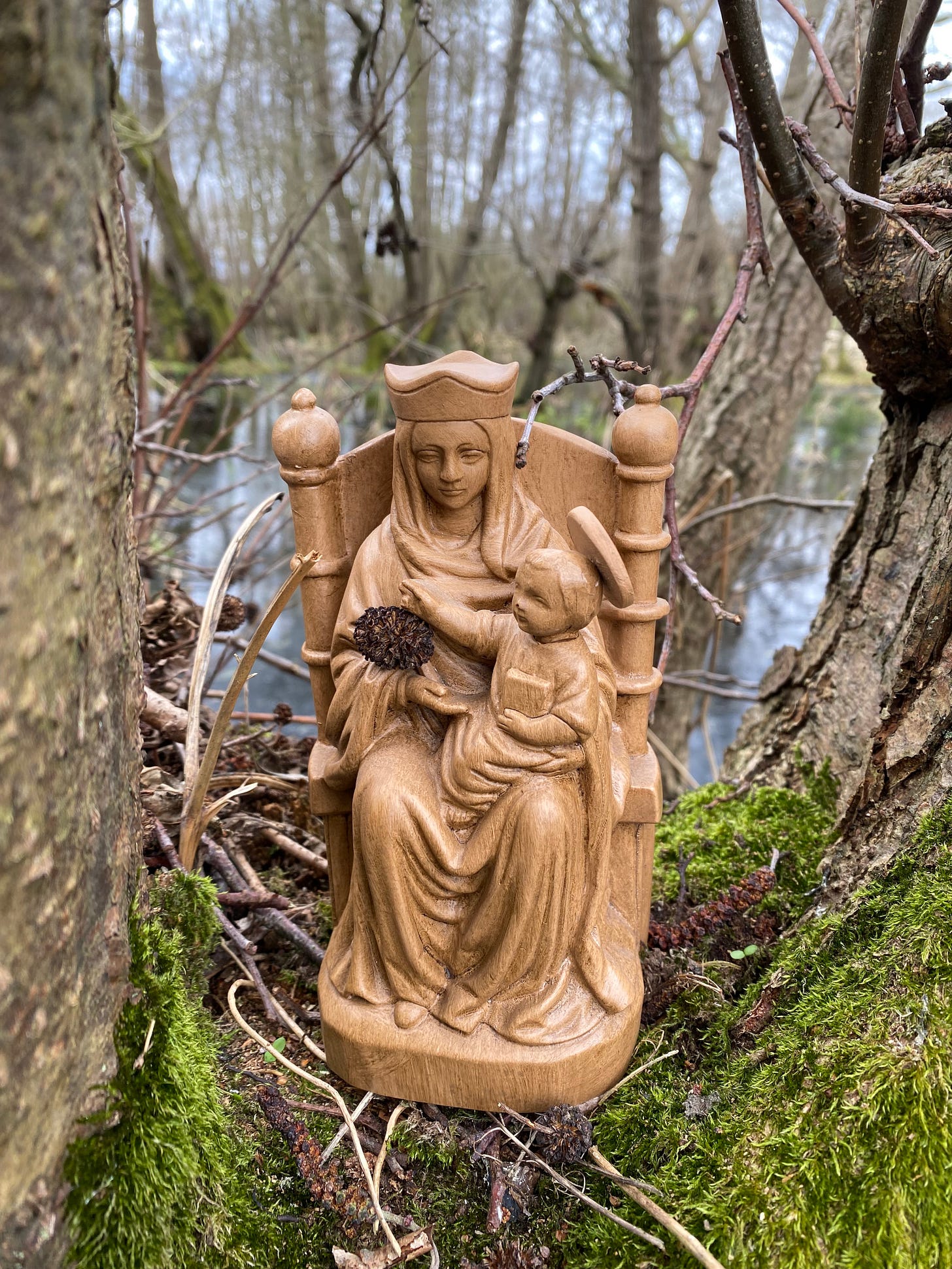
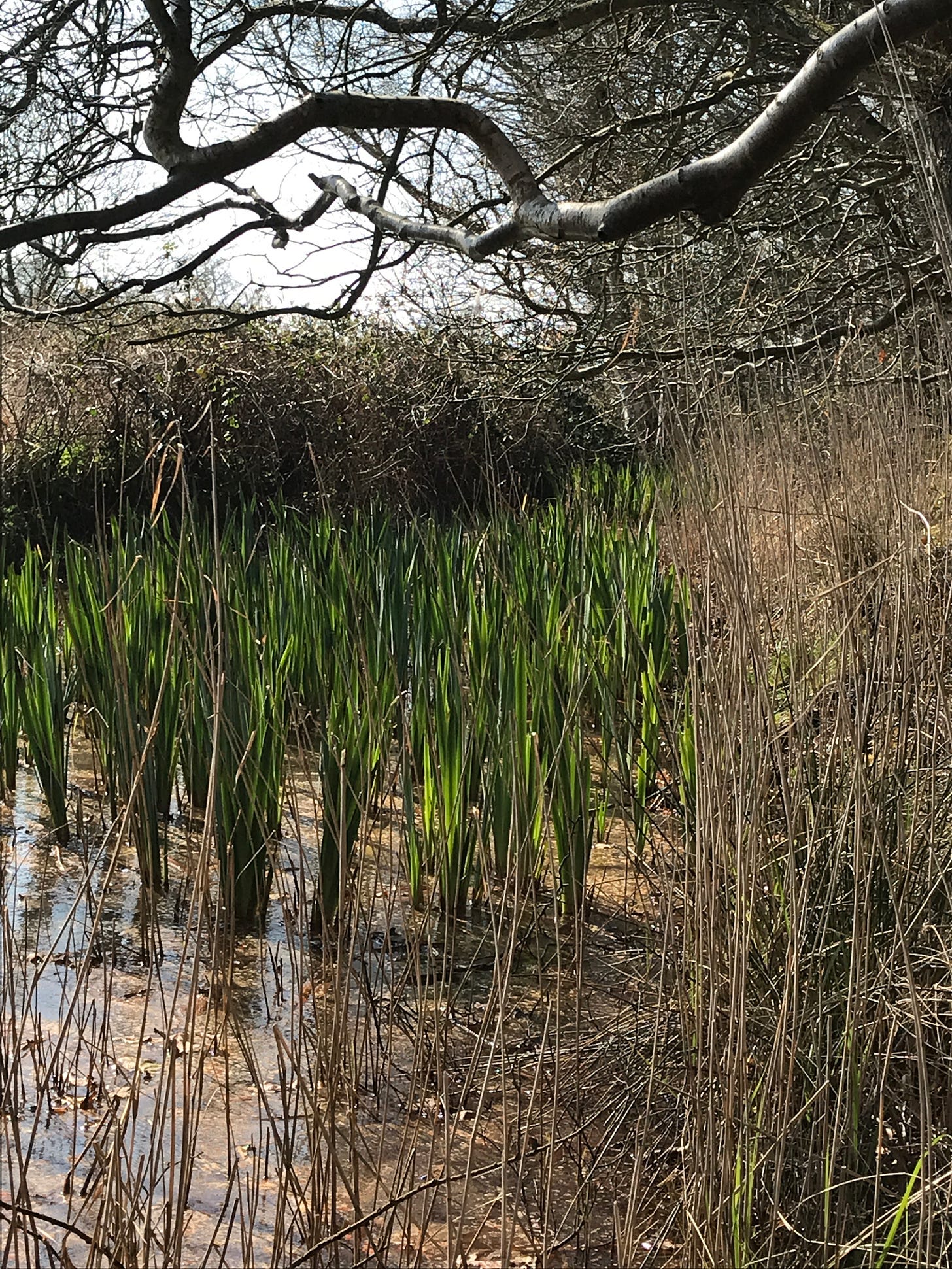
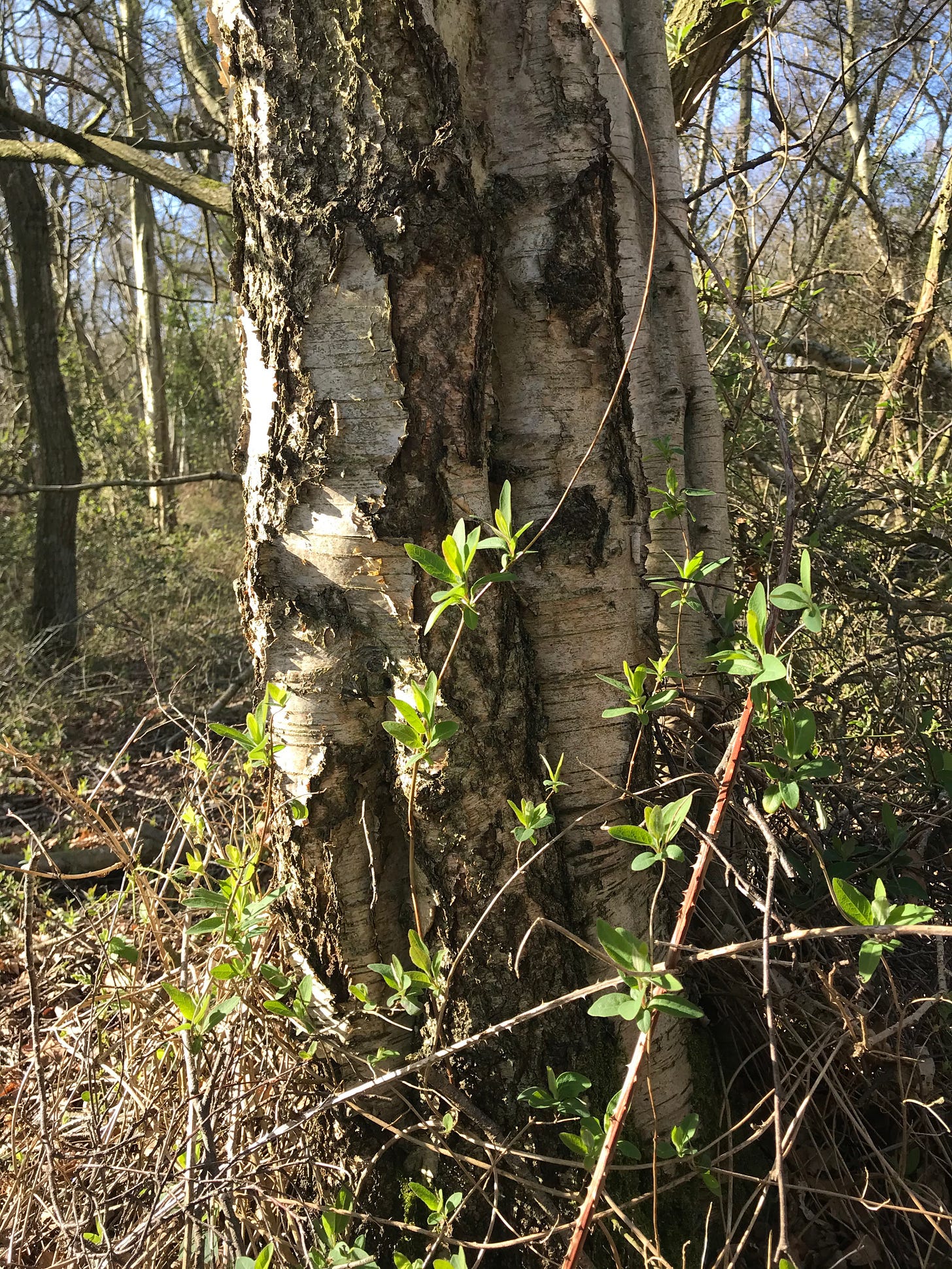


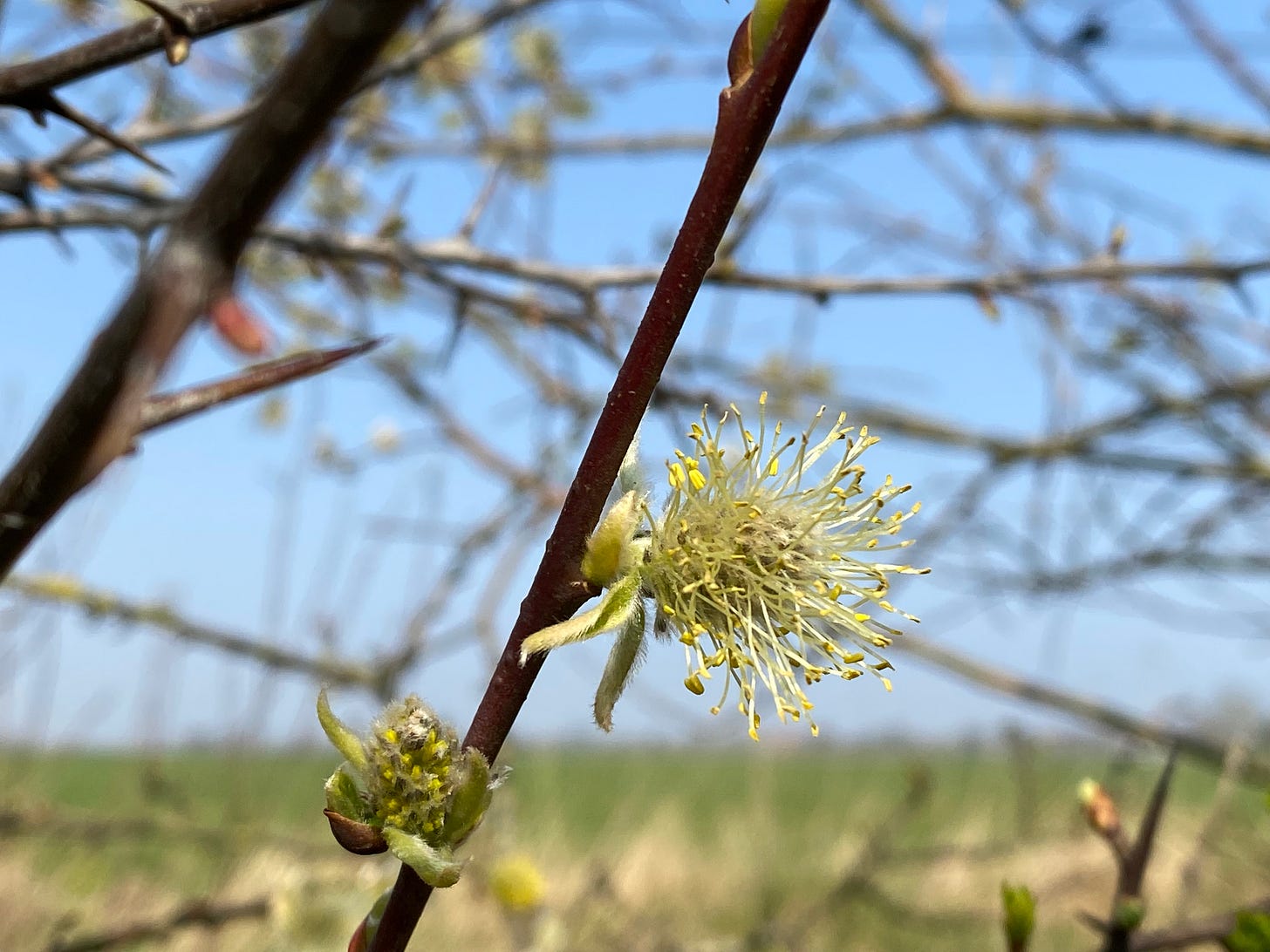
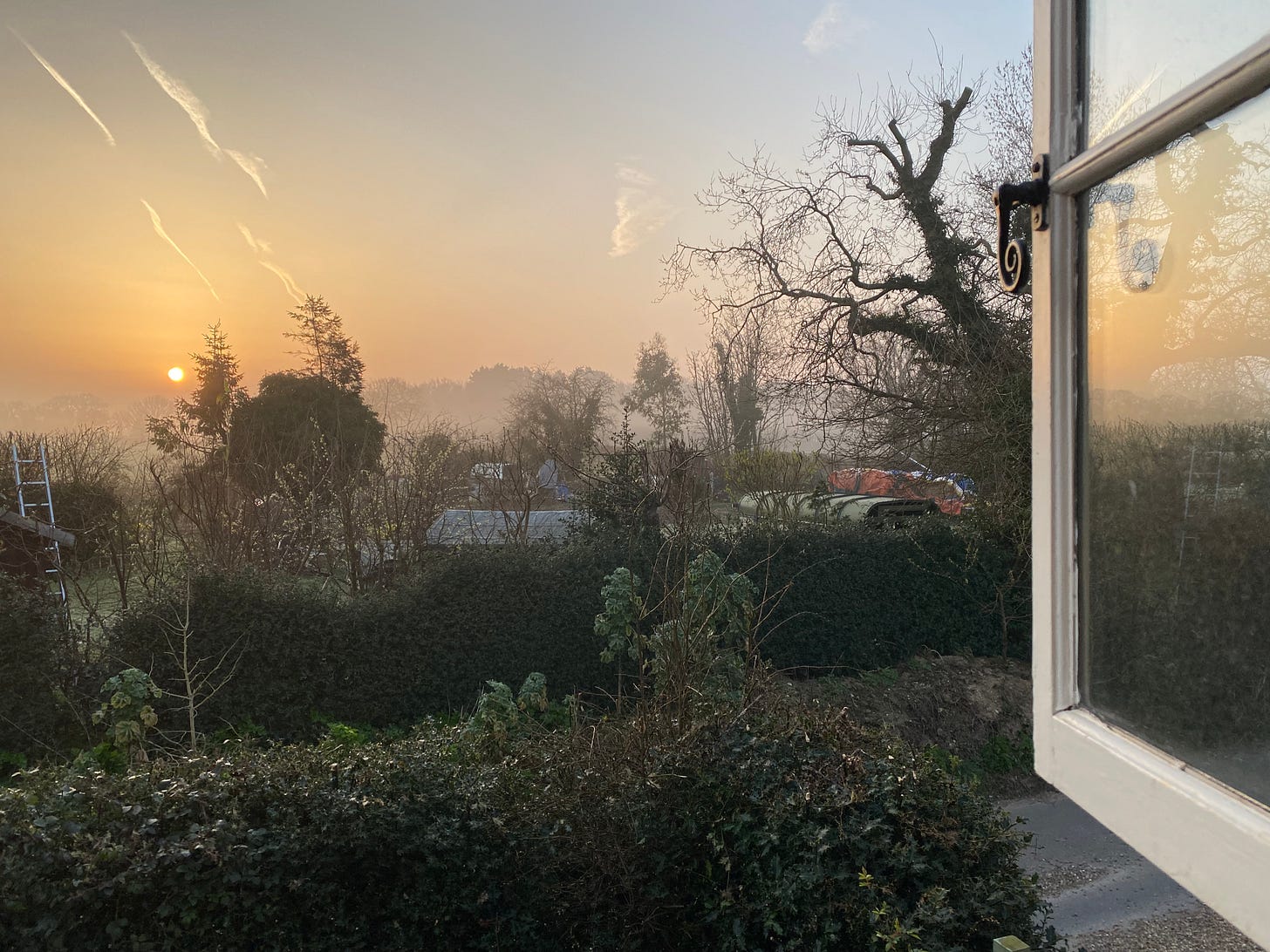

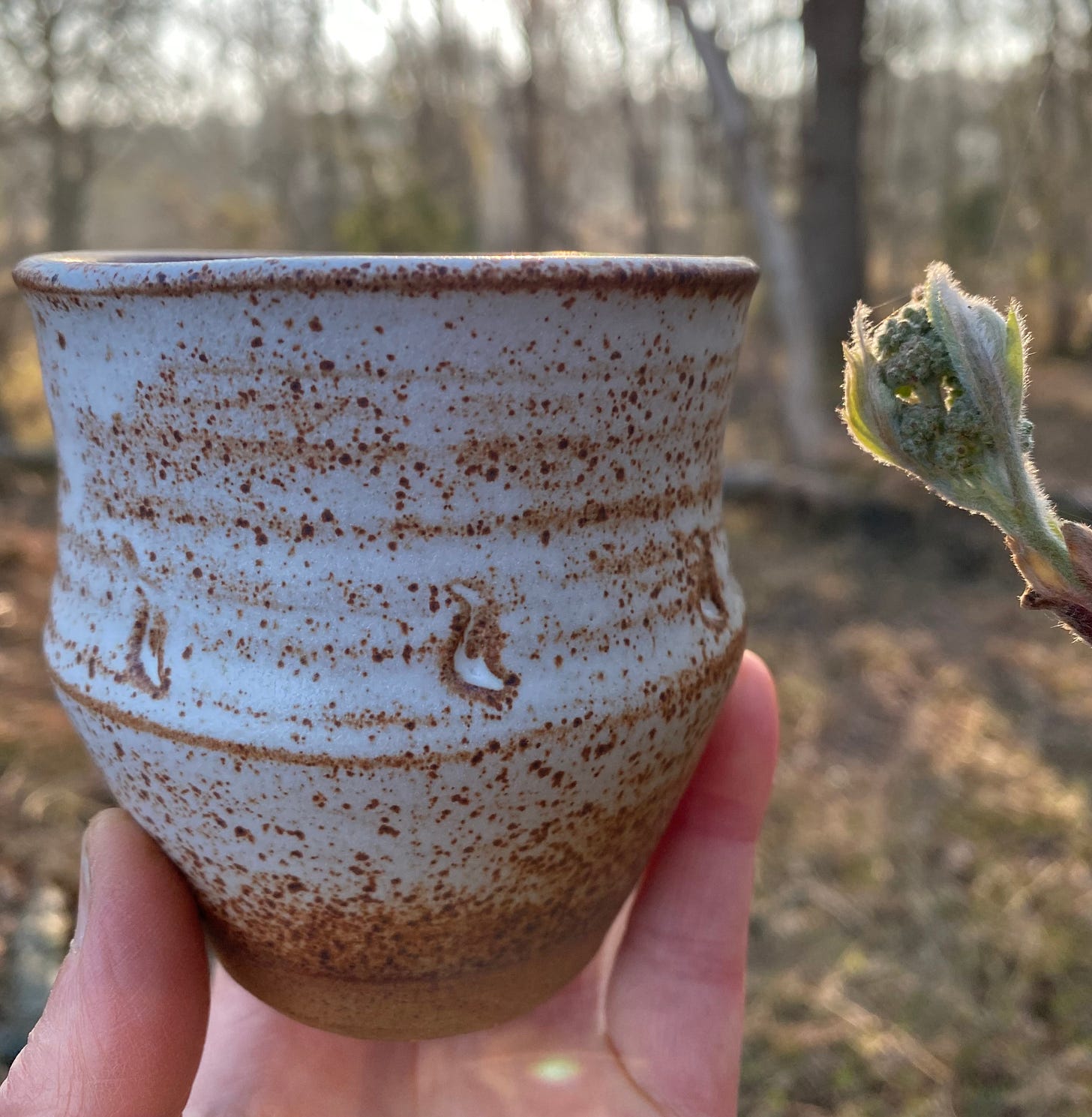
spraying 🤬 it happens here so much. And goes straight into our waterways. Just recently a large colony of freshwater crayfish were found dead from it. The local council ignore the plea to cease.
As always, a very enjoyable post, i look forward to them and would like to comment on the oak tree hole as it appears to be perfectly round .I have seen one like this too, made by a lesser woodpecker in a wood not that far from where I live, maybe you have one of these birds in your woods, They are rarely seen these day so I was very lucky to spy on the one I saw. I also enjoy your YouTube video's immensely, so thank you for doing all this work and sharing with us all. Blessings Veronica /l\